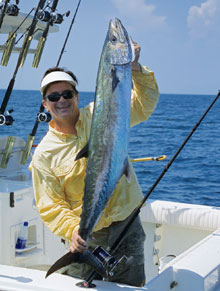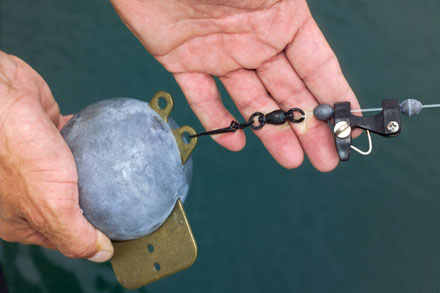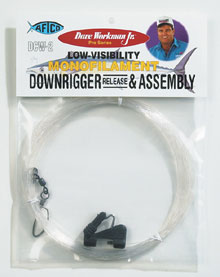Downrigger top shots reduce cutoffs and help the catch ratio.
By George Poveromo
 |
| The author dropped a downrigger bait to boat this big king. Photo: Rick Schneider |
Downriggers have been in the arsenal of king mackerel fishermen for many years, but those in the top tier of the sport have been modifying their deep-water tactics recently.
One such go-to technique is adding monofilament top shots to downrigger cables. When used on a downrigger, a mono top shot significantly reduces the vibration or "hum" that the standard cable produces at trolling speeds. The mono also cuts through the water with less resistance than the cable, helping to keep "blowback" '’’the planing of the downrigger line that can change the depth at which baits are trolled '’’in check. Most importantly, the top shot reduces the chances of a parted fishing line, should it contact the downrigger line. Here's how it works: A fish hits the bait, gets hooked and trips the fishing line from the downrigger release clip. The fish then takes off in a direction that will bring the fishing line in contact with the downrigger top shot. The lighter fishing line, which is tight to the fish, will almost always slice right through the heavier mono. While certainly causing the loss of the downrigger ball and terminal arrangement, the top shot saves the fish.
While not always a good trade for the weekend angler, top-shotting downriggers is popular among those who slow-troll live baits for kingfish, particularly in competitions with prize money on the line. Kings are notorious for striking baits with speed and force, often running across the bait spread or toward the boat. When this happens, it is not unusual for the fishing line to part if it brushes against a downrigger cable. The fish is lost, along with any prize money it may have netted.
Get the Lead Out
I recently had the privilege of fishing for king mackerel off Brunswick, Georgia, with Donna Gowen Poe.
A senior vice president with the First Bank of Brunswick, Poe is also a respected tournament angler. She and I were aboard my boat, Marc VI, slow-trolling live pogies along Gray's Reef and by the R-2 navigational tower, some 40 and 50 miles offshore, respectively.
Poe hooked our first big king on a live Spanish mackerel she jigged up from a school and quickly deployed on a downrigger. Mere moments after the Spanish was sent down, the king struck and Poe jumped on the rod. I was soon surprised to see both downrigger top shots flapping along on the surface a few seconds later. That big king had run across and sliced through both downrigger top shots, losing us two downrigger balls, release clips and swivels. But it was absolutely worth it to start our day with a 28-pounder.
Later, another king sliced through a top shot, bringing our total loss to four downrigger balls, four release clips and 12 swivels. But the monofilament top shots worked as we planned, sacrificing the gear to save hooked fish.
While that seemed like a bad day for downrigger balls, anglers can go all year and never have a fish run across their downrigger line.
Or they can go out and quickly lose four setups in one day. One thing is certain: Had I opted against the monofilament top shots, we would have lost those kings.

This downrigger terminal setup uses egg sinkers to keep the release clip from binding on the knots or crimp sleeves.
Photo: Rick Schneider
Take a Shot
So how much 100-pound mono is an effective top shot? That depends on how deep the baits are being fished. If an angler is deploying downriggers to fish in water less than 50 feet deep, 100 feet of mono is fine �’remember to factor in the angle caused by blowback. To fish depths approaching 100 feet, spool up with at least 200 feet, and preferably 300 feet of monofilament.
When top-shotting, do not remove the cable from the downrigger spool, as it is necessary as a base. Spooling up with all monofilament will spread the spool and ruin the downrigger. Instead, simply join the monofilament to the cable with a sleeve, and crimp the connection. Wind on the top shot, and then crimp on a 200-pound-test snap swivel. When it's time to fish, just clip on the terminal setup.
For the terminal arrangement, use two feet of 100-pound-test mono. Crimp or tie a barrel swivel onto the end of the mono, which will join to the downrigger's snap swivel. Next, slide a plastic bead or tiny egg sinker onto the line, followed by a release clip and another bead or sinker. At the end, crimp or tie on a 200-pound-test ball-bearing snap swivel. The plastic beads or sinkers act as spacers, preventing the release clip from binding against the knots or sleeves connecting the snap swivels. The snap swivel attaches to the downrigger ball.
More Than Kings
Smaller five-pound cannonballs are preferred when slow-trolling in shallow water and where there's not much current. The lighter weights are easier to handle and cause less wear and tear on the downrigger. When there's a problem with blowback, or if I'm trolling lures or baits at faster speeds, I opt for the standard ten-pound weight. I've found it pays to keep at least a half-dozen downrigger balls onboard.
This rig is not just for kingfish. Downrigger top shots can improve catch rates on any species hooked while the downriggers are deployed '’’particularly wahoo, which often act like king mackerel, and cross lines with downriggers.
Some question the logic of losing a downrigger weight, release clip and swivels '’’setups that cost upwards of $20 each. Poe and I went through about 80 bucks worth of terminal gear. But think about how much it cost to get on the water that day: fuel, bait, lunch, ice and more. Would I rather risk a quality fish to save $20? Of course not, and I can't think of any serious angler who would. Downrigger top shots improve the odds with big, fast fish.

Boxed Top
Slow-trollers interested in using the mono downrigger top shot can try a pre-rigged one to start. The Dave Workman Jr. Pro Series Low-Visibility Monofilament Downrigger Release & Assembly ($19) from AFTCO includes 100 feet of 100-pound mono, a Goldfinger release clip and everything else needed to set up a downrigger top shot. For information, call AFTCO at (949) 660-8757 or visit www.aftco.com.
'’’G.P.

